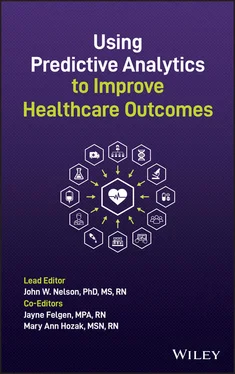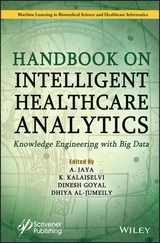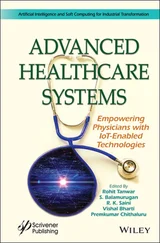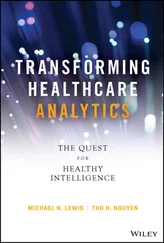Using Predictive Analytics to Improve Healthcare Outcomes
Здесь есть возможность читать онлайн «Using Predictive Analytics to Improve Healthcare Outcomes» — ознакомительный отрывок электронной книги совершенно бесплатно, а после прочтения отрывка купить полную версию. В некоторых случаях можно слушать аудио, скачать через торрент в формате fb2 и присутствует краткое содержание. Жанр: unrecognised, на английском языке. Описание произведения, (предисловие) а так же отзывы посетителей доступны на портале библиотеки ЛибКат.
- Название:Using Predictive Analytics to Improve Healthcare Outcomes
- Автор:
- Жанр:
- Год:неизвестен
- ISBN:нет данных
- Рейтинг книги:5 / 5. Голосов: 1
-
Избранное:Добавить в избранное
- Отзывы:
-
Ваша оценка:
- 100
- 1
- 2
- 3
- 4
- 5
Using Predictive Analytics to Improve Healthcare Outcomes: краткое содержание, описание и аннотация
Предлагаем к чтению аннотацию, описание, краткое содержание или предисловие (зависит от того, что написал сам автор книги «Using Predictive Analytics to Improve Healthcare Outcomes»). Если вы не нашли необходимую информацию о книге — напишите в комментариях, мы постараемся отыскать её.
Discover a comprehensive overview, from established leaders in the field, of how to use predictive analytics and other analytic methods for healthcare quality improvement. Using Predictive Analytics to Improve Healthcare Outcomes
before
proven in advance
Using Predictive Analytics to Improve Healthcare Outcomes
Using Predictive Analytics to Improve Healthcare Outcomes — читать онлайн ознакомительный отрывок
Ниже представлен текст книги, разбитый по страницам. Система сохранения места последней прочитанной страницы, позволяет с удобством читать онлайн бесплатно книгу «Using Predictive Analytics to Improve Healthcare Outcomes», без необходимости каждый раз заново искать на чём Вы остановились. Поставьте закладку, и сможете в любой момент перейти на страницу, на которой закончили чтение.
Интервал:
Закладка:
If you think of clinical competence as being the combination of relational competence and technical competence—which implies that there is no clinical competence without relational competence (Koloroutis & Trout, 2012)—you will understand more fully how important it is to measure the effect that caring, clarity, and relationships have on healthcare outcomes. As you learn about the ways in which predictive analytics are being used to improve outcomes in healthcare, notice the vital role that the context of care plays every time. It is not just the technical aspects of care that are being measured now, because it is not just the technical aspects of care that matter. Caring, clarity, and relationships matter, so we are measuring them.
There is no clinical competence without relational competence.
Note
1 1Felgen & Koloroutis, 2007.
3 Cultivating a Better Data Process for More Relevant Operational Insight
Mary Ann Hozak
An organization's performance improvement plan has traditionally been based on data that measures a compilation of (a) demographic information, (b) prevalence of outcomes such as use of restraints or pressure injuries, and (c) percentage of policy compliance such as: How many falls? How many appointments were canceled? Were patients happy or unhappy? What percentage of the form was completed? Although helpful as a starting point for identifying and quantifying quality indicators, the only thing these scores really show us is an abundance of data points moving up or down each month. They indicate whether a specific task is being performed well or poorly, but they do little to help us understand the big picture. Since “task performance” is an inadequate measure of professional practice, we need to rethink what we are measuring and how we are measuring it.
Since “task performance” is an inadequate measure of professional practice, we need to rethink what we are measuring and how we are measuring it.
Data collection itself is challenging. How do you decide what to collect or where to collect it, and how can you be sure it is collected the same way for every audit or that every auditor is auditing the same way? Then, once it is collected, what is the best way to present the data to help communicate with others what new realities you have come to understand?
Most often, data is collected manually, with some information technology assistance, which is a very arduous process. Once collected, however, the data is not always analyzed to find and correct any collection errors and outlier information before it is distributed to people in the organization. This not‐necessarily‐valid performance improvement data is often then reported and discussed in committee meetings and staff council meetings. As you can imagine, the action plans created in response to this data can cause some serious problems. Using data without screening for error first is like putting a ship to sail before checking if the ship has holes in it.
Using data without screening for error first is like putting a ship to sail before checking if the ship has holes in it.
If the data is not checked for accuracy, anxiety and frustration build for staff members and leaders alike as the organization’s inconsistent data is then reported to Leapfrog, Hospital Compare, and the Magnet® Recognition program. The experience of anxiety for staff members and leaders is tied to the reporting of this data to regulatory and accreditation organizations, because these organizations report the hospital‐level data to the public who then make choices about what hospital they will go to. The frustration is tied to the ongoing struggle with trying to understand the fluctuation in scores. This fluctuation in scores, which is also frustrating to manage, suggests that other variables affecting the outcomes have not been measured or were not measured correctly. Given this pattern of collecting, distributing, and acting on flawed data, with no sustainable improvement toward the goals of high reliability, patient safety, and full reimbursement opportunities, the question is: How can we get our hands on data that includes everyone on all units and points us toward the precise actions we can take to improve operations?
Taking on the Challenge
In our organization, the first step in getting out of the problematic data cycle was realizing that the quality committee members were clinicians and business administrators, not data analysts who can translate all those numbers into valid, reliable, widely consumable information. It had become clear that the money we were spending on the work of the quality committee was like spending three dollars on a bottle of wine, and then expecting to have a substantive conversation about the virtues of a truly fine wine. If we wanted to go beyond shuffling papers full of data to having a data process that truly informs, we needed to invest time and resources into experts in this field. It was clear that a more systematic and scientific data management structure and equally systematic and scientific processes were needed if our organization was to positively impact patient care, staff satisfaction, and financial outcomes. To develop the appropriate structures and processes necessary to maximize the reliability, validity, relevance, and consumability of the current data, executive leaders hired a data analyst trained in research methods, measurement models, and predictive analytics to assist the team. It should be noted that this PhD prepared data analyst had been a bedside nurse for 11 years and was familiar with our framework of care, Relationship‐Based Care® (RBC) (Creative Health Care Management, 2017; Koloroutis, 2004), so he understood our context very well. We felt as if we had struck gold.
In our initial and subsequent Magnet® journeys, RBC had been chosen as the care delivery model by the organization because it aligned so thoroughly with our mission and vision. Through our work implementing RBC, we quickly discovered that staff members who have clarity about who they are, what their role is, and how the healthcare system works, were demonstrating better and more sustainable outcomes (Hozak & Brennan, 2012; Nelson & Felgen, 2015; Nelson, Nichols, & Wahl, 2017). Showing evidence of this rapid improvement, however, required a different approach, since “clarity of self, role, and system” were very unusual things to measure. It required administrators to trust that even though measuring caring and clarity did not directly measure costs or outcomes, a model that improves caring and clarity does make a financial impact in the long run, and it was therefore worth the time and investment to study these variables.
A model that improves caring and clarity does make a financial impact in the long run.
The quality committee partnered with the data analyst to measure clarity of self, role, and system, as we learned there was already a measurement instrument developed that could show us what positive outcomes clarity predicts (Felgen & Nelson, 2016). We used predictive analytics to study how clarity related to nurse job satisfaction, and how this impacted (a) caring as reported by the patient, (b) caring as reported by the care providers, (c) sleep quality of the patients, and (d) HCAHPS scores. Through this work, we discovered that our hunches about what we were implementing in RBC were right: increased clarity resulted in increased job satisfaction which in turn improved caring as reported by both patients and care providers (Nelson & Felgen, 2015). We also found that staff members who had higher job satisfaction also had patients who reported higher HCAHPS scores and better sleep during their hospital stay. We did strike gold!
Through our use of predictive analytics, we measured what was long thought unmeasurable, as we demonstrated that the concepts taught in RBC did matter.
Читать дальшеИнтервал:
Закладка:
Похожие книги на «Using Predictive Analytics to Improve Healthcare Outcomes»
Представляем Вашему вниманию похожие книги на «Using Predictive Analytics to Improve Healthcare Outcomes» списком для выбора. Мы отобрали схожую по названию и смыслу литературу в надежде предоставить читателям больше вариантов отыскать новые, интересные, ещё непрочитанные произведения.
Обсуждение, отзывы о книге «Using Predictive Analytics to Improve Healthcare Outcomes» и просто собственные мнения читателей. Оставьте ваши комментарии, напишите, что Вы думаете о произведении, его смысле или главных героях. Укажите что конкретно понравилось, а что нет, и почему Вы так считаете.












